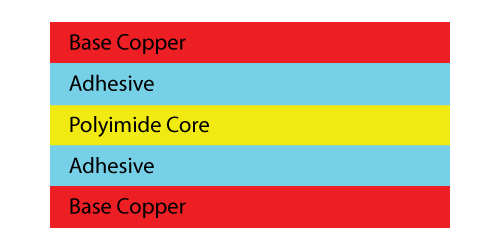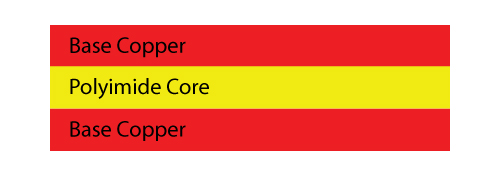Two distinct types of polyimide flex core material constructions are utilized in today’s flex circuit manufacturing: adhesive based and adhesiveless. The difference, as you can probably tell from the name, is the method used to attach the copper layers to the polyimide core. This creates a unique set of material properties for each of the material types which must be factored into designs to meets all requirements and remain cost effective.
Adhesive vs Adhesiveless Flex Cores
Adhesive Based flex cores utilize a layer of flexible adhesive which bond, under heat and pressure, each copper layer to the polyimide core. The adhesive is typically either epoxy or acrylic based and 0.0005" to 0.001" in thickness.

Adhesive Based Flex Cores
Adhesiveless flex cores have the copper directly attached to the polyimide core without the use of any adhesives.

Adhesiveless Flex Cores
Adhesive Based Flex Core Benefits:
- Reduced Material Costs
- Higher Copper Peel Strengths (Dependent Upon Adhesive Type Used)
Adhesiveless Flex Core Benefits:
- Reduced Flex Thickness
- Due to Elimination of Adhesive Layers
- Improved Flexibility
- Due to Reduced Finished Flex Thickness
- Tighter Possible Minimum Bend Radius
- Due to Reduced Finished Flex Thickness
- Improved Plated Hole Reliability in Higher Layer Count Flex Designs (i.e. 3- 7 layer designs)
- Reduces Number of Layers of Adhesive Within the Flex Construction
- High Co-Efficient of Thermal Expansion of Flex Adhesives can Place Plated Holes Under an Excessive Z-Axis Stress During Assembly/Operation Which can Lead to Hole Plating Cracks
- Higher Potential Temperature Ratings
- Flex Adhesives have a Substantially Lower Max. Operating Temperature than Polyimide
- Improved Controlled Impedance Signal Characteristics
- Homogenous Construction of only Polyimide Between Signal Layers and Reference Planes.
- Required to meet IPC 2223C Rigid Flex Design Guidelines
- Eliminates and or Reduces the Use of Flex Adhesive within Rigid Areas
- Improved Plated Hole Reliability
- Better Suited to Harsh Environment Applications
Polyimide Flex Core Material Availability
Both material types are available with a range of Polyimide core thicknesses and copper weights. 0.001" and 0.002" are the most commonly used and cost effective core thicknesses. Thicker and thinner cores are available to meet unique specific design requirements. Thicker cores(greater than 0.002") may be required for impedance controlled designs, etc., but have a negative impact on flexibility, reliability, and cost. Thinner cores(less than 0.001") are available for very thin flex designs that require maximum flexibility, but negatively impacts cost.
Both material types are also available with a range of copper thicknesses, with 0.5 oz and 1 oz being the most common and cost effective. Thicker and thinner copper weights are again available to meet specific requirements. Thicker copper(greater than 1 oz) for higher current carrying requirements and thinner copper(less than 0.5 oz) for high circuit density and more flexible designs. Both negatively impact cost as compared to the 0.5 and 1 oz standards.
Which Flex PCB Adhesive method is best for me?
This depends upon many elements of a specific design. A full electrical and mechanical design review is recommended to ensure the design is optimized. Please feel free to contact us if you have any questions or need assistance in selecting the correct material type for your design.
Summary
In flex circuit manufacturing, the choice between adhesive based and adhesiveless polyimide cores has a significant impact on performance, reliability, and cost. Adhesive based cores use epoxy or acrylic layers to bond copper to polyimide, offering lower material costs and strong copper peel strength. Adhesiveless cores eliminate the adhesive layer, resulting in thinner, more flexible constructions with improved bend radius, higher temperature resistance, and better plated hole reliability. Both material types come in a range of core thicknesses and copper weights, making the right selection dependent on a project’s electrical, mechanical, and environmental requirements. A thorough design review is the best way to determine which construction method fits your application.
Key Takeaways
- Adhesive based flex cores are cost-effective and provide higher copper peel strength but add thickness and limit flexibility.
- Adhesiveless flex cores reduce thickness, improve bend radius, and enhance reliability in multilayer and harsh environment designs.
- Thermal performance differs significantly, as adhesives have lower maximum operating temperatures compared to pure polyimide.
- Material availability is flexible, with standard core thicknesses of 0.001" and 0.002" and copper weights of 0.5 oz and 1 oz as the most cost-efficient.
- Design requirements drive the choice, with adhesiveless cores preferred for impedance control and high-reliability needs, and adhesive based cores suited for simpler, cost-sensitive applications.

















